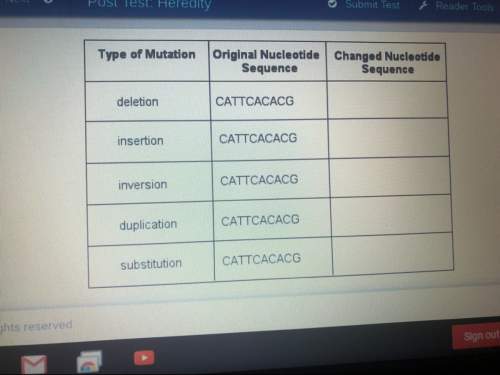Why are most systems in the human body negative feedback systems?
A) Positive feedback r...

Biology, 24.03.2020 05:26 NateTheBeast12
Why are most systems in the human body negative feedback systems?
A) Positive feedback restricts body temperature and keeps it controlled.
B) Positive feedback systems don’t work well with electrically charged neurons.
C) Negative feedback systems allow humans to regulate and stabilize their systems.
D) Negative feedback systems balance the overall positively charged human organs.

Answers: 2


Another question on Biology

Biology, 21.06.2019 19:20
If vegetable oil is made out of veggies, then what is baby oil made out of?
Answers: 2

Biology, 21.06.2019 20:00
Two male mice, which we will call male a and male b, are both phenotypically normal. male a was from a litter that contained half phenotypically normal mice and half dwarf mice. the mother of male a was known to be homozygous for the normal igf2 allele. male b was from a litter of eight mice that were all phenotypically normal. the parents of male b were a phenotypically normal male and a dwarf female. male a and male b were put into a cage with two female mice that we will call female a and female b. female a is a dwarf and female b is phenotypically normal. the parents of these two females were unknown, although it was known that they were from the same litter. the mice were allowed to mate with each other, and the following data were obtained: female a gave birth to three dwarf babies and four normal babies. female b gave birth to four normal babies and two dwarf babies. which male(s)mated with female a and female b? male a with both females male a with female b, and male b with female a male a with female a, and male b with female b could not be determined male b with both females
Answers: 3

Biology, 21.06.2019 20:30
Match the descriptions / definitions with the term they best describe 1. three dimensional relationship of the different polypeptide chains in a multisubunit protein or protein complex 2. common folding pattern in proteins in which a linear sequence of amino acids folds into a right-handed coil stabilized by internal hydrogen-bonding between polypeptide backbone atoms. 3. the amino acid sequence of a protein 4. a region on the surface of a protein that can interact with another molecule through noncovalent bonding. 5. three-dimensional arrangement of alpha-helices and beta-sheets within a single polypeptide, typically stabilized by a variety of noncovalent bonds, including ionic and hydrogen bonds, and nonpolar interactions / hydrophobic force. 6. the chain of repeating carbon and nitrogen atoms, linked by peptide bonds, in a protein. 7. common structural motif in proteins in which different sections of the polypeptide chain run alongside each other and are joined together by hydrogen bonding between atoms of the polypeptide backbone. 8. portion of a polypeptide chain that has a discrete tertiary structure of its own and can often fold independently of the rest of the chain 9. regular local folding patterns in a protein, including alpha-helix and beta-sheet a. primary structure b. beta-sheet c. protein d. coiled-coil e. polypeptide backbone f. secondary structure g. side chain h. tertiary structure i. binding site j. alpha-helix k. quaternary structure l. protein domain
Answers: 2

Biology, 22.06.2019 01:00
How does this experiment explain why it is often milder in areas such as coastal maryland while areas such as kansas or iowa have more extremes in temperature
Answers: 3
You know the right answer?
Questions


Chemistry, 23.07.2019 09:00






Advanced Placement (AP), 23.07.2019 09:00


Social Studies, 23.07.2019 09:00



Mathematics, 23.07.2019 09:00





Physics, 23.07.2019 09:00


Physics, 23.07.2019 09:00




